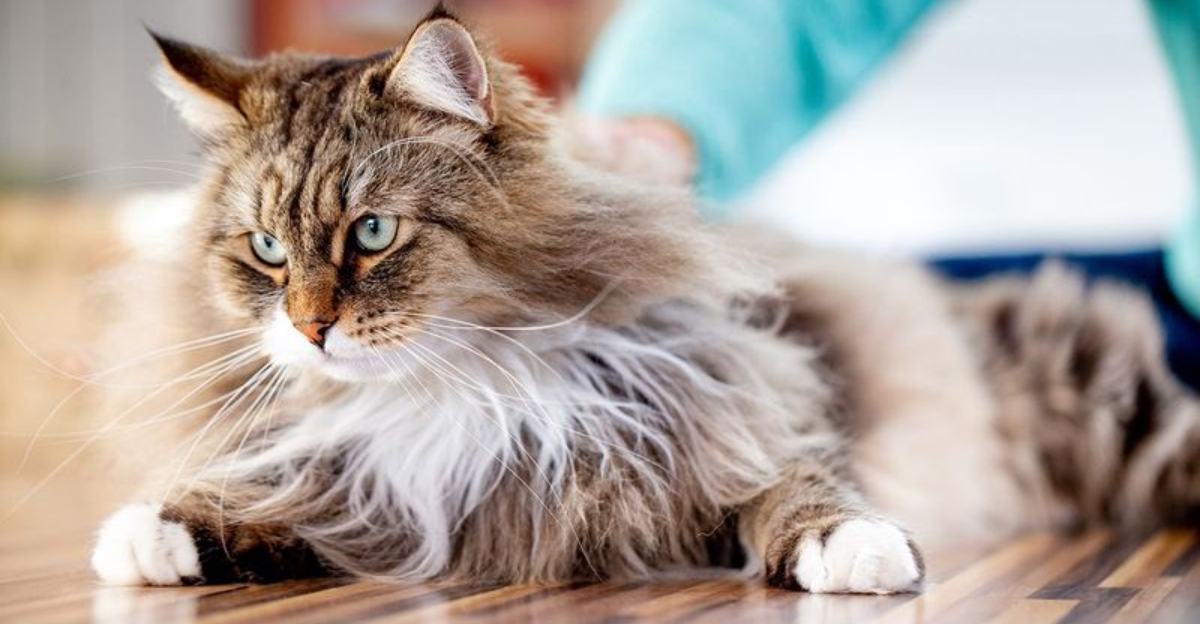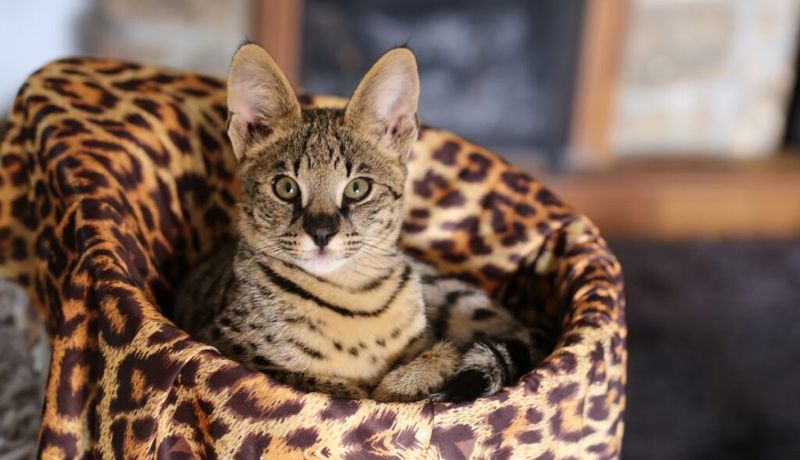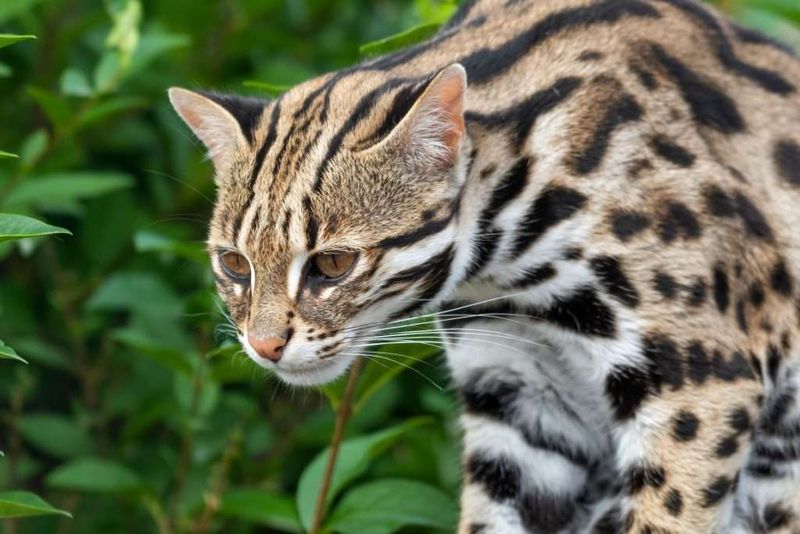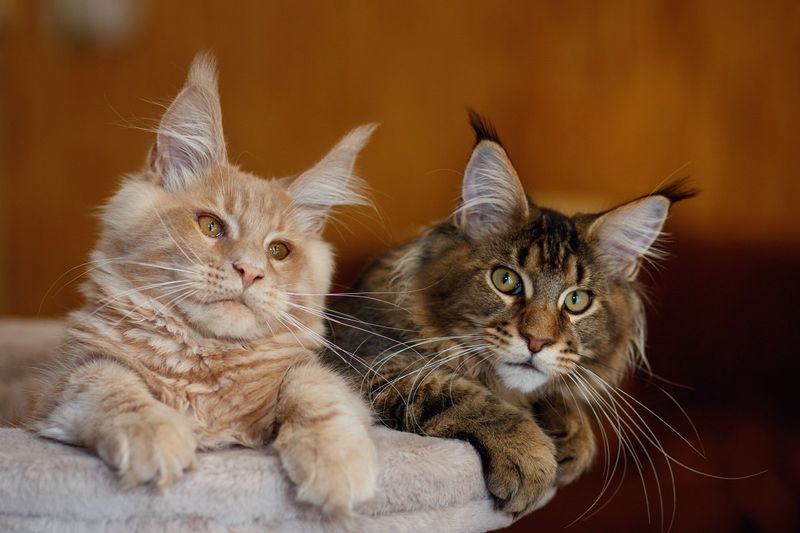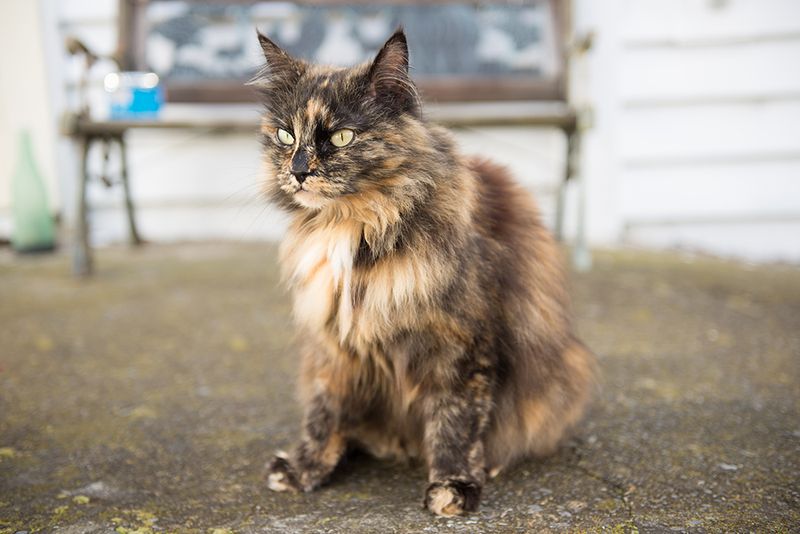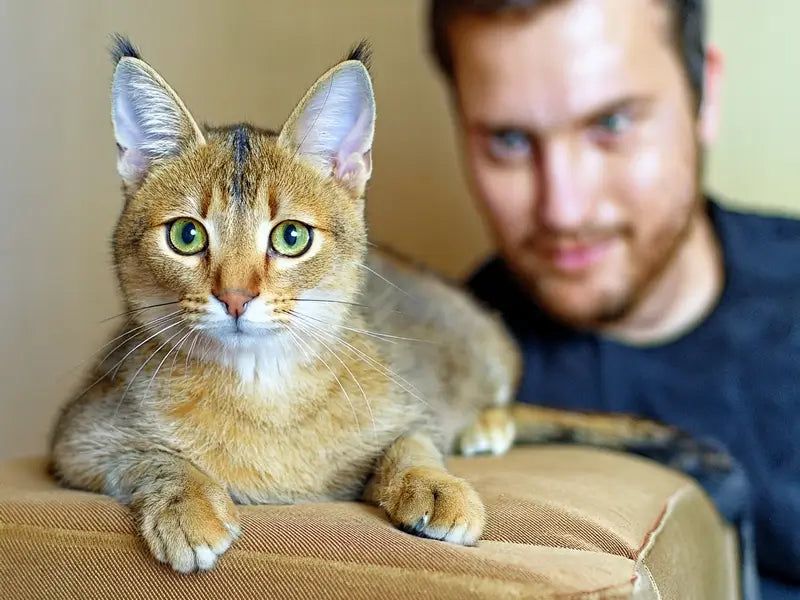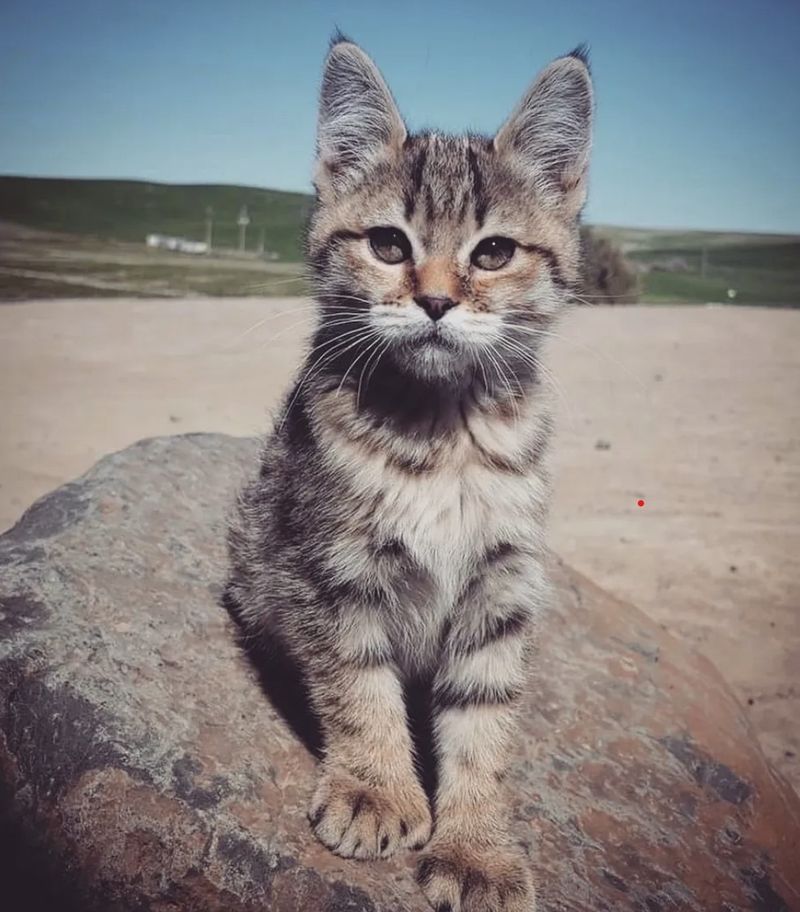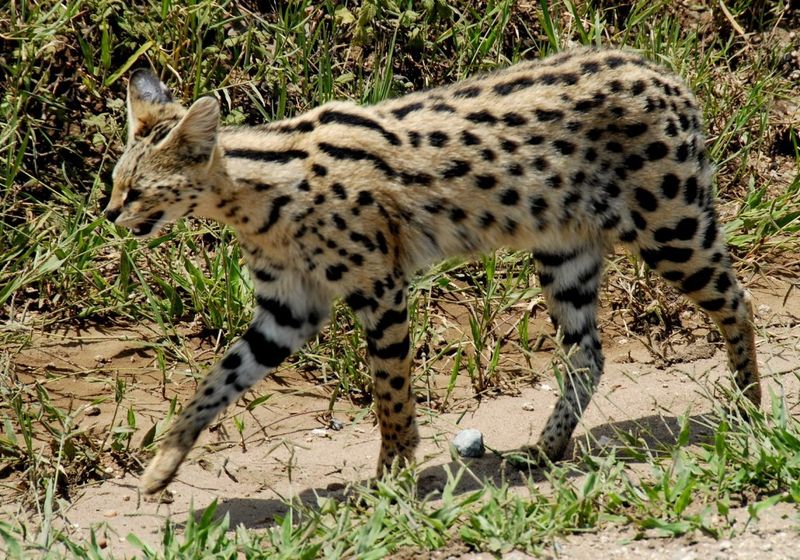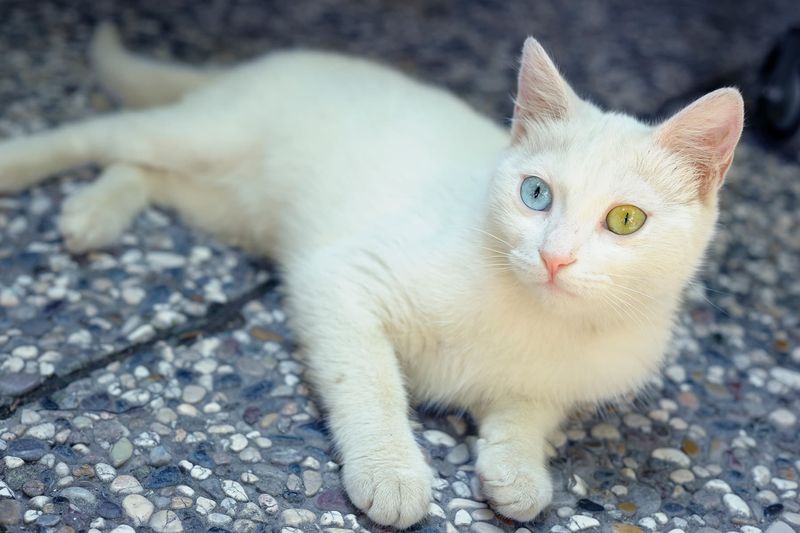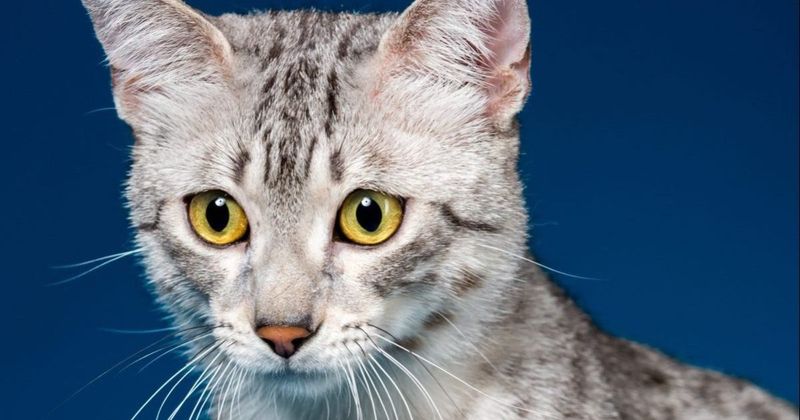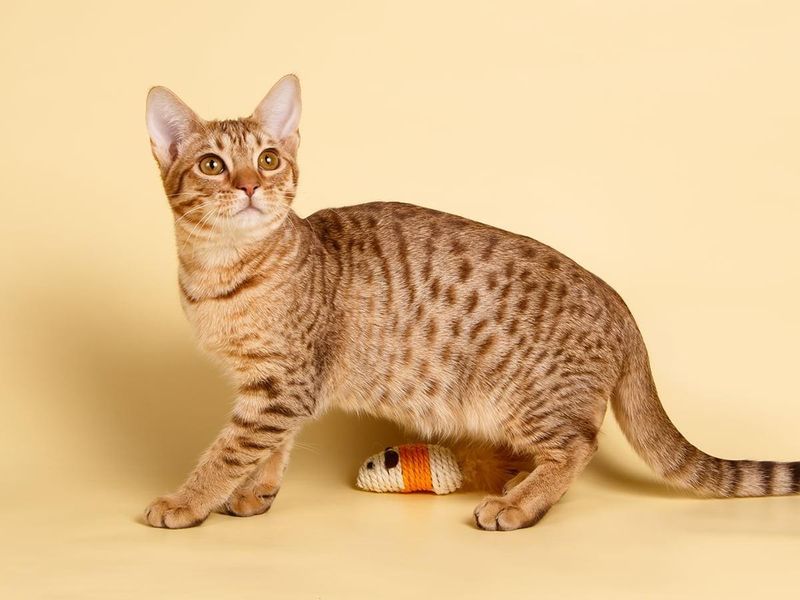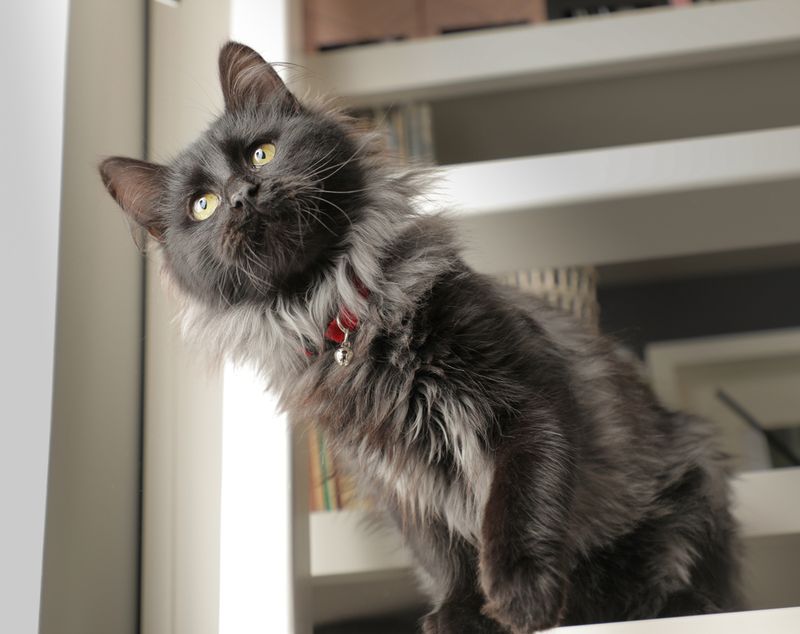📖 Table of Content:
Certain cat breeds demand far more than food, grooming, and affection. Their striking presence is matched by complex behaviors and high energy levels that require thoughtful handling. These cats are not ideal for the casual pet owner.
With roots that often trace back to wild ancestry or working roles, these felines carry traits that set them apart. Strong instincts, territorial tendencies, and bold temperaments are common characteristics. Understanding their needs is essential for building a balanced relationship.
Such breeds can offer deeply rewarding companionship to those who meet their challenges with respect and patience. Their intelligence and intensity create bonds built on mutual understanding. These cats thrive in environments that engage both their bodies and minds.
1. Savannah
Half domestic cat, half African serval – Savannahs are the tallest domestic cats around. They can jump up to 8 feet high from a standing position! These energetic felines require tons of mental stimulation and physical activity.
Savannahs form intense bonds with their owners but aren’t typically lap cats. They’re more interested in interactive play and exploring their surroundings. First-generation Savannahs (F1s) are so wild-like that they’re illegal in some states. Many Savannahs enjoy water and can be taught to walk on leashes. Their diet requires special attention, too, as they have specific nutritional needs that differ from those of average house cats.
2. Bengal
Bengals look like they just walked out of the jungle with their wild leopard-like spots and muscular bodies. These cats never seem to run out of energy. They’re constantly climbing, jumping, and exploring every corner of your home. Known for their intelligence, Bengals can learn tricks, open doors, and even turn on faucets because they love running water.
Their vocal nature means they’ll chat with you throughout the day with chirps and trills rather than typical meows. Without proper stimulation, these clever cats become destructive. They need puzzle toys, high perches, and interactive playtime to keep their active minds satisfied.
3. Maine Coon
Gentle giants of the cat world, Maine Coons can weigh up to 25 pounds and stretch nearly 4 feet long from nose to tail tip. Despite their imposing size, they’re known as “gentle giants” with playful personalities that last well into adulthood. Their thick, water-resistant coats require regular grooming to prevent painful mats.
Maine Coons have distinctive chirping trills and tend to be more dog-like in their loyalty, often following their owners from room to room. These powerful cats are skilled hunters by nature. Even pampered indoor Maine Coons maintain strong prey drives and need toys that simulate hunting to stay mentally fulfilled.
4. Siberian
Powerful forest cats from Russia, Siberians evolved to survive harsh winters with their triple-layered, water-resistant coats. Males can weigh up to 20 pounds of solid muscle. They’re exceptional jumpers and climbers who need sturdy cat trees that won’t topple under their weight. Siberians take up to five years to fully mature, remaining kitten-like and playful much longer than other breeds.
Their intelligence makes them problem-solvers who can figure out puzzles and even open doors. Despite their wild appearance, they form incredibly strong bonds with their families. They’re known to greet their owners at the door and follow them around the house like loyal companions.
5. Norwegian Forest Cat
Viking companions of old, Norwegian Forest Cats have muscular bodies built for climbing and hunting in Scandinavian forests. Their double-layered waterproof coats protected them during harsh northern winters. These cats have tufted ears, bushy tails, and toe tufts that once helped them navigate snowy terrain.
While independent, they’re not aloof – they simply operate on their own schedule. Norwegian Forest Cats are patient and gentle but require regular exercise to maintain their athletic physiques. Their strong claws and powerful hind legs make them exceptional climbers who appreciate tall cat trees and shelving systems. Without vertical space, these natural explorers can become bored and destructive.
6. Chausie
Created by crossing domestic cats with jungle cats, Chausies retain wild instincts while adapting to home life. Their long, powerful legs enable incredible jumping ability – they can easily reach the top of refrigerators and cabinets from a standing position. Chausies need extensive physical activity and mental stimulation.
They’re not content being decorative pets and require interactive play sessions multiple times daily. Their diet needs special attention too, as many have sensitivities to grains and plant-based ingredients. These cats bond deeply with their families but can be wary of strangers. They maintain kitten-like energy well into adulthood and aren’t suitable for owners seeking a calm, predictable companion.
7. Pixie-Bob
Often mistaken for bobcats due to their wild appearance, Pixie-Bobs have muscular bodies, spotted coats, and naturally short “bobbed” tails. Some even have extra toes (polydactyl), giving them remarkable dexterity for opening cabinets and doors. These intelligent cats can be taught to walk on leashes and enjoy outdoor adventures with their owners.
They’re known for dog-like loyalty, often following their people from room to room and coming when called by name. Pixie-Bobs make chattering sounds rather than traditional meows. They mature slowly, taking up to four years to reach full size and emotional development, meaning owners need patience during their extended adolescence.
8. Serengeti
Serengetis possess the exotic look of wild African servals without actual wild blood. Their exceptionally long legs and necks give them a distinctive silhouette unlike any other domestic cat. Athletic and agile, they can leap impressive heights from standing positions. These cats form strong attachments to their owners but aren’t typically lap cats.
They prefer interactive play and exploration over cuddle sessions. Serengetis are incredibly vocal and will hold lengthy “conversations” with their humans throughout the day. Their high energy levels require substantial daily exercise. Without proper outlets, they may develop destructive behaviors or excessive vocalization. Cat wheels and tall climbing structures are essential for their physical and mental well-being.
9. Abyssinian
Ancient Egyptian royalty in feline form, Abyssinians possess boundless energy and athletic prowess. Their ticked coats shimmer with each movement as they race through the house. These cats rarely sit still – they’re constantly in motion, exploring every corner of their territory. Abyssinians maintain kitten-like playfulness throughout their lives.
They excel at learning tricks and can be trained to retrieve toys. Their curiosity leads them into everything – expect to find them investigating open cabinets, drawers, and appliances. While affectionate, they show love through playful interaction rather than cuddling. They need engaging toys, climbing opportunities, and daily interactive play sessions to prevent boredom-induced mischief.
10. Turkish Van
Turkish Vans are powerful swimmers nicknamed “swimming cats” for their unusual love of water. Their unique cashmere-like coats repel water, allowing them to dry quickly after their aquatic adventures. These muscular cats can weigh up to 20 pounds and need substantial space to exercise. Famous for their “Van pattern” – white bodies with colored heads and tails – they’re also known for their mismatched eyes (one blue, one amber) in many individuals.
Their powerful hind legs make them exceptional jumpers who will reach the highest points in your home. Late bloomers, Turkish Vans don’t reach full maturity until 3-5 years old. They remain playful and kitten-like well into adulthood, requiring patient owners who appreciate their energetic antics.
11. Bombay
Mini panthers for your living room, Bombays combine the exotic look of wild cats with domestic temperaments. Their muscular bodies and gleaming black coats make them look like they stepped straight out of the jungle. The breed was specifically developed to resemble miniature black panthers. Bombays are surprisingly heavy for their size due to their dense muscle structure.
They love being the center of attention and will follow their people everywhere. These social creatures don’t do well when left alone for long periods. Their intelligence makes them easy to train – many can learn to walk on leashes or perform tricks. Bombays are known for their distinctive purr, which is louder and more persistent than most domestic cats.
12. Egyptian Mau
Egyptian Maus are the only naturally spotted domestic cat breed and the fastest housecats in the world. They can run up to 30 mph thanks to longer hind legs and a unique flap of skin extending from flank to back knee that allows greater stride length.
These athletic cats have excellent hunting instincts and will chase anything that moves. Their spotted coats provide natural camouflage, making them masters of stealth. Egyptian Maus form intense bonds with their chosen people but can be reserved with strangers. They’re sensitive to temperature and prefer warm environments. Their vocalizations include chirps, trills, and unique sounds not typical of other breeds – they literally speak their own language!
13. Toyger
With their bold coloring and tiger-like stripes, Toygers capture the essence of the jungle in a domestic form. This breed was carefully developed to highlight the importance of tiger conservation. Energetic and strong, they thrive on interactive play and daily challenges.
They enjoy interactive toys, puzzle feeders, and climbing structures. Their intelligence enables them to be quick learners, mastering tricks and even basic commands. Unlike their wild inspirations, Toygers are social and affectionate companions who bond closely with their families. They typically get along well with other pets but still need outlets for their natural hunting instincts through play.
14. Ocicat
Despite their exotic, leopard-like markings, Ocicats have no wild ancestry. They are muscular and agile, excelling at climbing, jumping, and quick bursts of speed. Known for their affectionate nature, they thrive in homes where they receive plenty of attention and interaction.
They’re known for greeting visitors at the door and showing dog-like devotion to their owners. These intelligent cats can learn their names and come when called. Their energy levels remain high throughout adulthood. Interactive play sessions are essential for their mental and physical well-being. Many Ocicats enjoy playing fetch and can be taught to walk on leashes for supervised outdoor adventures.
15. Korat
Beneath their elegant silver-blue coats, Korats hide a surprising amount of strength and muscle. Hailing from Thailand, they are often associated with luck and wealth. Their intelligence is notable, often leading them to master the art of opening doors and cabinets with ease.
They’re problem-solvers who need mental stimulation to prevent boredom. Their strong-willed nature means they can be stubborn when determined to get their way. Korats form intense bonds with their chosen people and can be possessive of their owners. They prefer quiet environments and may become stressed in chaotic households with unpredictable schedules.
16. Burmese
Burmese cats pack surprising weight and muscle into their medium-sized frames. When picked up, most people are shocked by how dense and heavy these powerful cats feel. Their satin-like coats come in several colors, with the classic sable brown being most recognized. These social butterflies demand attention and involvement in all household activities.
They’ll follow their owners everywhere and insist on “helping” with tasks from cooking to computer work. Burmese are known for their dog-like loyalty and will come when called. Their playful nature persists throughout life. Even senior Burmese enjoy interactive games and learning new tricks. They’re vocal cats who use an array of sounds beyond typical meows to communicate their needs and desires.
17. Tonkinese
Combining the strength of Burmese with the elegance of Siamese markings, Tonkinese cats are both striking and sturdy. They excel at jumping and often surprise with their vertical reach. Their compact bodies are packed with muscle, making them feel heavier than they look.
Mischievous and clever, Tonkinese cats quickly learn how household items work – including door handles and faucets. They’re persistent when they want something and will find creative ways to achieve their goals. Their intelligence requires regular mental challenges to prevent boredom. Tonkinese form strong bonds with their families and don’t tolerate being ignored. They’ll insert themselves into activities by sitting on keyboards, books, or whatever has your attention instead of them.
18. Chantilly-Tiffany
With flowing, silky fur and muscular bodies, Chantilly-Tiffany cats strike a balance between elegance and strength. Their hunting instincts remain sharp, hinting at their active and alert nature. Most recognized for their rich chocolate coats, they also appear in various other hues.
They enjoy interactive play sessions that challenge both mind and body. Chantilly-Tiffanys are known for their sweet, chirping voices rather than loud meows. They form deep attachments to their families but aren’t typically demanding of attention. These patient cats adapt well to household routines and can entertain themselves when necessary, though they still need regular interaction.
19. Somali
Resembling foxes with their expressive faces and bushy tails, Somalis are the long-coated counterparts of Abyssinians. Their high energy levels and curious nature leave little time for lounging. These agile felines are natural athletes, often seen leaping onto shelves or racing through hallways.
They need tall cat trees and climbing opportunities to satisfy their natural desire for height. Their intelligence makes them excellent problem-solvers who quickly learn how to open doors and cabinets. Somalis aren’t typically lap cats but show affection by staying near their favorite people. They’re known for their playful antics and will entertain themselves by batting toys around or creating their own games.
20. Turkish Angora
Graceful in appearance, Turkish Angoras hide athletic strength beneath their silky coats. Their strong hind legs support remarkable vertical jumps and agile climbing. These cats move with a regal air, often surprising with their energetic and curious personalities.
They claim the highest points in the home as their own and survey their territory from these vantage points. Despite their refined looks, they’re determined hunters who maintain strong prey drives. Turkish Angoras bond closely with their chosen people but can be selective about when they want attention. They’re intelligent cats who quickly learn household routines and adapt their behavior accordingly.
